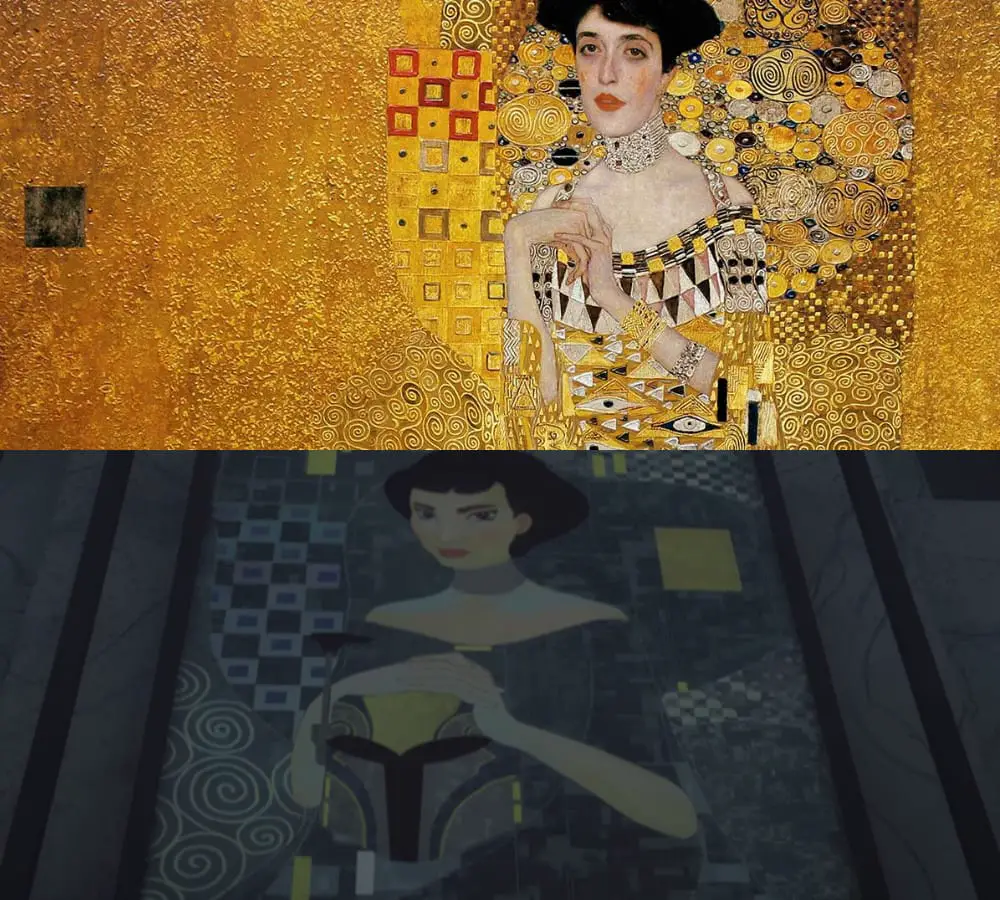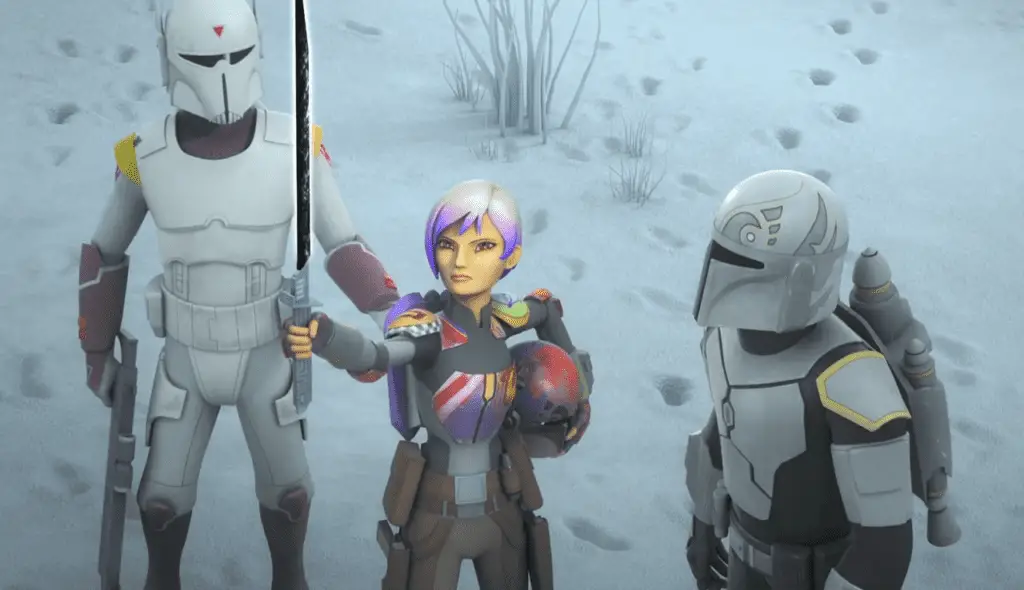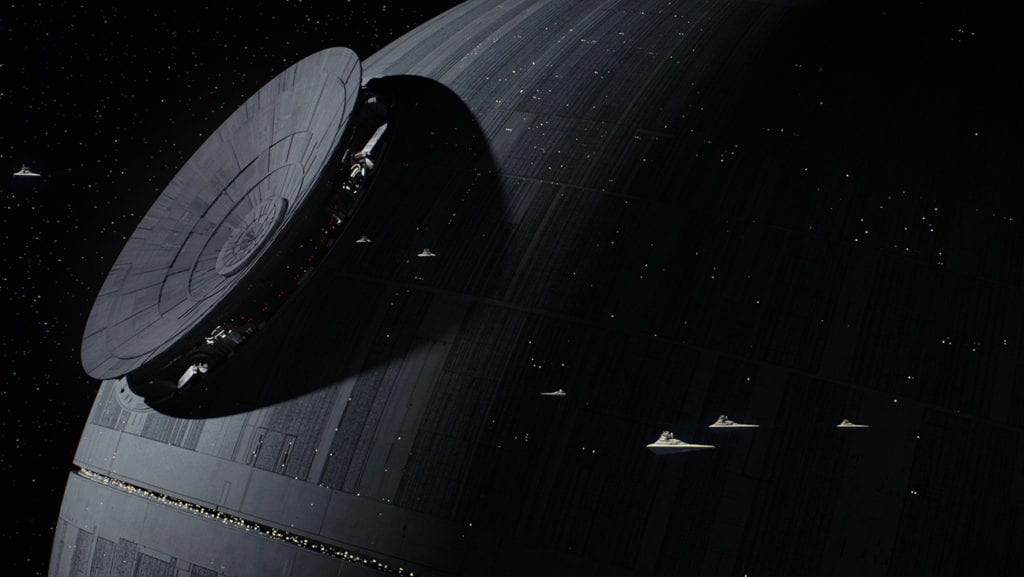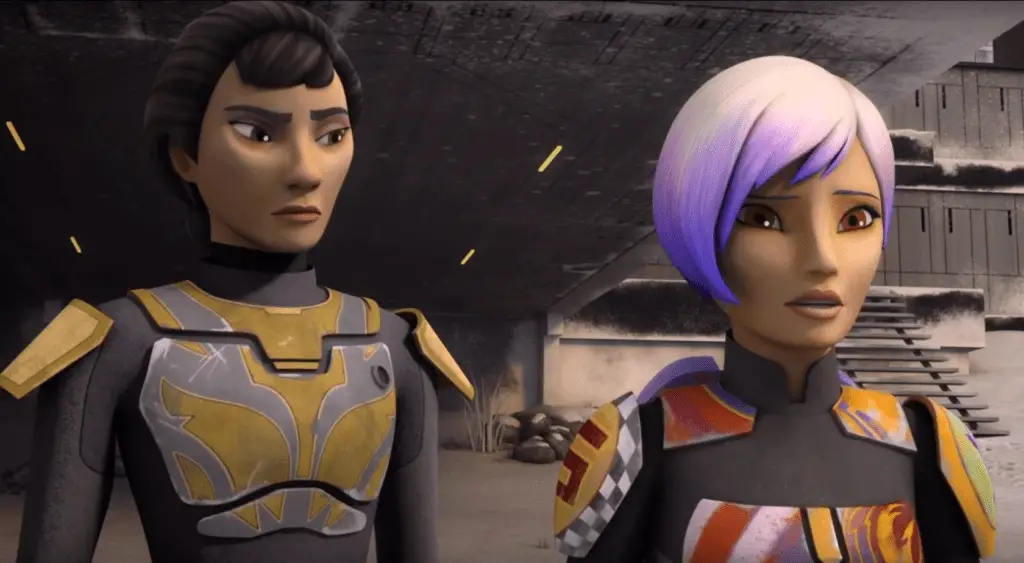This is it. This is the episode you have all been waiting for. Stunning art direction, emoting characters, complex familial dynamics, and breathy action all combine into twenty-minutes of televised perfection. The art direction of “Legacy of Madalore” creates the perfect mood, the overall themes of the show shine brightly, and we find teasers of what might lie in store for the rebels and the galaxy as a whole. It will be hard to top this episode.

Overview
Deep in the midst of the Mandalorean Krownest, aka Space-Russia, Sabine, Ezra, Kanan, and Fenn Rau head for the most potentially-deadly family reunion since we met Cham Syndulla. After a brief skirmish with the Mandalorians in the sky, the four of them crash-land. Fenn Rau stays hidden, while the other three are brought back to meet Sabine’s mother: Ursa Wren. In an attempt to return Sabine to the fold and remove the stain from the family name, Ursa offers Governor Gar Saxon the lives of Kanan and Ezra in exchange for clemency for Sabine.
However, in his typical self-serving fashion, Saxon instead attempts to wipe out Clan Wren because he is a petty piece of crap. As the two sides start fighting, Saxon and Sabine go mano-a-mano on a frozen lake which, surprisingly, does not break. Sabine wins and refuses to kill Saxon, but Saxon tries to shoot her in the back, prompting Sabine’s mother to finally kill him. ? ? ? Thereafter, Sabine elects to stay with her family and seek out someone worthy to wield the Darksaber against the Empire.
Art of Krownest
As the series progresses, the art-salt that Zach felt in the beginning is beginning to be diluted. (Nick is incredibly relieved.) This episode in particular used the environment for some truly magnificent storytelling. For one, the Stronghold of Clan Wren is a callback to Madalore itself. It is all right angles, clear plate glass, and pale, desaturated elements. The wiki mentions that Sabine was born on Mandalore, and the buildings reflect this. They look like a small slice of Sundari smack in the middle of nowhere.
However, while Mandalore was bright, sunny, and dry with the Mandalorians wearing colorful armor, Krownest is literally a world apart. Gray clouds fill the sky, snow covers the ground, and everything is dim and desaturated. Even the armor is a cool gray, as Dave Filoni explained:
“I just wanted to show, color wise, that the life had been sucked out of them.”
This artistic choice could even be applied to Gar Saxon and his supercommandos: Service to the Empire has forced them to sacrifice everything that made them Mandalorians.

It should also be pointed out that Mandalorians in general have a strong connection to art. In The Clone Wars Duchess Satine Kryze’s portrait looks cubist. The massive mural commemorating the Mandalorian crusade against the Jedi seems heavily inspired by ancient Maya art. Sabine uses a highly stylized and graphic style for her art, but the piece de resistance has to be Duchess Ursa Wren’s portrait, which beautifully evokes Gustav Klimt’s Portrait of Adele Bloch-Bauer I. Basically, all the artists on staff are showing their art history credits
The Darksaber’s Role
We were both pleasantly surprised that the dark saber wasn’t an easy solution to Mandalore’s or Sabine’s problems. While still symbolic, it is still just that, a symbol. In fact, Ursa says as much in the show.
“Your Rebel friends are going to bring the Empire down on all of us. You believe the Darksaber will protect you? It won’t. It’s only a symbol.”
Ultimately a symbol needs some action or meaning behind it. It needs substance, otherwise it’s useless. The episode is such that Sabine not only has to bring the Darksaber with her, but use it for her character to succeed. She needs to give meaning to it for it to be truly powerful. Her clan’s defeat of Gar Saxon gives meaning to the Darksaber, and paves the way for Sabine’s legacy.

Family Comes First
The emerging theme of this whole series is the power of familial love. We saw it before with Hera and Cham, both of whom are willing to give their lives for each other, and also with Commander Jun Sato, who is willing to risk a pitched battle with Thrawn to save his nephew, Mart. As shown in “Trials of the Darksaber”, Sabine loves her family deeply, and it was her love for them that drove her to flee. She could not bear the thought that the Empire might use her weapons against her family.
Likewise, Tristan proves his loyalty to his family in many ways. Of course he resents Sabine, too; it was her weapons that laid Mandalore low and her defection that brought ruin upon their family. But every look that passes between them shows how much he loves her. When he hears Sabine’s name he immediately calls for a stop to the shooting, even though he would probably be greatly rewarded for killing her. He is willing to humble himself and work for Gar Saxon, the man who is responsible for how far their family has fallen, in the hope that this loyal service will redeem the honor of his family.
“All of Fenn Rau’s people are dead; mine are not, and I intend to keep them that way. All of them.”—Ursa
Ursa herself goes to any lengths necessary to protect her family and proves this in an interesting way. When Sabine arrives, Ursa knows how greatly she would be rewarded if she gave Sabine to Gar Saxon. Instead, she offers Saxon the lives of two Jedi and shows absolutely no remorse or hesitation. All of this is done for the chance that Sabine will be allowed to return home safely. In her ultimate act of familial love, Ursa kills the Governor of Mandalore, the man hand picked by the Emperor to lead the sector, to save her daughter. The wrath of the Empire is sure to follow, but it is a small price to pay for her daughter.
Although, every member of her family says, “You should not have come back”, it is not because they despise her. It is because they all love her deeply and know that every moment she spends in their company is a risk to her own life. They would rather never see her again if it meant her safety.
A Dynamic Ezra
As we have mentioned before, Ezra’s personality can vary wildly from episode to episode. His various aspects include Emozra, who is angry and emotional, Stezra, who channels Steven Universe for a cheery attitude with conflict resolution skills, Cornflakezra, who functions as a filler when episodes need lightsabers, and Confused Ezra, whose ignorance allows for exposition. While he usually maintains one of these personalities for the duration of the episode, Ezra is showing a more nuanced characterization now, mostly bouncing back and forth between Stezra and Emozra. It makes one wonder if, as a rounded character, one of Ezra’s characterizations might be a front. He keeps it cheerful most of the time, but as soon as things get tense he becomes deadly serious, and sometimes downright dangerous.
Ursa and Her Conflicts
One of the best parts of this episodes was Sabine’s mom, Ursa. A major themes for her character was her conflicting loyalties. She has to juggle: 1) Leading an entire clan; 2) Traversing old and traditional Mandalorian politics; 3) Protecting her entire family, despite how spread out they are across their society; 4) Determining how she’ll face the future with all the other factors in mind; and 5) Dealing with how she works with her own feelings through all of this. With these in mind, it’s fascinating to see how focused she is on making the right decision while also doing the right thing.
One of her main conflicts was how she dealt with Sabine. Above all Ursa wants to protect her family and actually considered Sabine to be safer when she ran away. However, Sabine showing up on her doorstep put her in a tenuous situation. The wrong decision could spell possible doom for her husband, Sabine, or even her entire clan. That being the case, even her more ambiguous decisions (like handing over the Jedi) become understandable as she works so hard to protect her family from the fury of Gar Saxon. Even her betrayal of Sabine is ultimately for Sabine’s benefit. Every action she takes is an attempt to make sure her family and clan survives.
Sabine and Her Arc
This episode is the culmination of Sabine’s arc. She started the series as a mysterious person with a reclusive, hidden past, and self-exiled from culture. She ends it returning home, usurping the Empire’s puppet to pave the way for the revitalization of Mandalore.
Sabine also tackles her internalized guilt, quashing the problems she had been holding her back, and starting to let herself grow. Sabine becomes confident, strong, and even questions her mother about her motivations and how she has handled her clans politics. She is no longer holding back, and instead fully communicating her feelings and issues to her mother.
Even her bittersweet decision to stay with her clan is a capstone. She is no longer a Rebel to her family, and she is no longer running. She is now facing her problems head-on, a true force (*ba-dum tiss*) to be reckoned with.
Sabine and “The Weapon”
In the previous episode, “Trials of the Darksaber,” Sabine mentions that part of the reason she left the Empire was because the weapons she designed were used against Mandalore, with devastating results. However, during her fight with Gar Saxon, Saxon insists that he will capture her alive and bring her back to “finish what she started”. This implies that, as devastating as Sabine’s earlier projects were, she was working on something even worse.
From The Clone Wars we can see that the Mandalorians are no pushovers. It took the full might of the Republic over a significant amount of time to end the Siege of Mandalore, and that was while Mandalore itself was caught in a civil war. Whatever Sabine was working on must have had truly devastating power to force a capitulation. Something that has significant engineering issues which requires great minds to see it through to completion. What kind of weapon is that?

Episode Rating
10 – Electrifying: YES,YEESSSS! Too good for the galaxy, too pure. Leaves the viewer with a feeling of deep emotional catharsis and stimulation. Worth infinite rewatches with the volume turned all the way up. This rating truly represents the Light Side of the Force.
Next Week
A Day in the Life of Agent Kallus with “Through Imperial Eyes.”
Images Coursey of Disney and Lucasfilm Story Group
[starbox id=”Nick,Zach”]


